Doo-Wop Groups
Bop
Chords
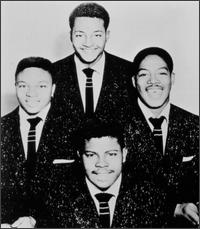
The Bop Chords were a musical group from Harlem, New York,
founded in 1955. They had a hit record titled Castle in the Sky.
Members:
Ernest Harrison - lead
William Dailey - first tenor
Ken Hamilton - second tenor
Morris Smarr - baritone
Leon Ivey - bass
Harlem's Bop Chords formed in 1955 in the same
building where the Ladders, Channels and Willows got their start.
Lead vocalist Ernest Harrison, William Dailey, Ken Hamilton, Leon
Ivey, and Morris Smarr had all sung with other neighborhood
groups, and Hamilton had recorded with the Five Wings earlier in
the year on a tribute to Johnny Ace that was issued by King. The
Bop Chords recorded for Holiday in 1956, and the midtempo
"Castle In The Sky" was a local and regional hit. Their
second single, "When I Woke Up This Morning," also did
well on the East Coast, but internal clashes over song content
and wardrobe soon caused lineup defections and changes. Dailey
and Smarr left and were replaced by Skip Boyd and Peggy Jones,
their first female vocalist. They recorded "Why" in
1957, then disbanded. Harrison did background vocals for Shep and
the Limelites and recorded "We Need Love" for Asnes in
1962 as Ernie Johnson. A new edition of the Bop Chords resurfaced
in 1971, with lead vocalist Johnson, Hamilton, Boyd and Ivey.
They never recorded, but were a popular attraction at various New
York locations and oldies shows in the '70s. ~ Ron Wynn,
All-Music Guide
Cadets
aka Jacks
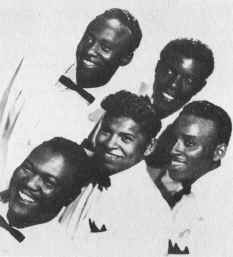
Clockwise from top: Willie Davis, Willie
"Dub" Jones, Aaron Collins, Ted Taylor, Lloyd McGraw
The Cadets had the most intriguing dual careers in rock and roll
history. From 1955-1957 they recorded and performed as both the
Cadets and Jacks. Each had their own hits, different sound and
direction
Members- Cadets:
Aaron Collins - lead Cadets/second tenor
Will "Dub" Jones - lead - Cadets and
Jacks/ bass - replaced by George Hollis
Ted Taylor - first tenor
Willie Davis - second tenor
Lloyd McCraw - baritone - replaced by Thomas
"Pete" Fox
Artist Biography by Ron Wynn
This West Coast group used two names for recording sessions. They
called themselves the Jacks when doing dates for Modern and the
Cadets on RPM. They began as a gospel group during the late '40s
in Los Angeles. Ted Taylor, Aaron Collins, Lloyd McCraw, and Will
Jones were the original lineup, and the Cadets were among the
more popular bands doing R&B covers. The Cadets' lone hit was
"Stranded in the Jungle," which they recorded for
Modern as the Jacks in 1956. It peaked at number eight R&B
and number 15 pop. Davis and Collins would later join the Flares
in 1961, while Taylor would enjoy solo success as a blues, soul,
and gospel vocalist. Jones joined the Coasters in 1958 and
remained there for over a decade. Collins' sisters, Betty and
Rose, also recorded for Modern/RPM as the Teen Queens.
Cadillacs
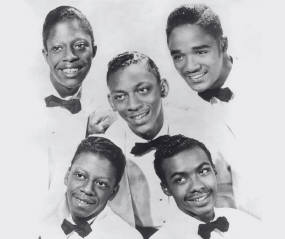
Top (L-R) Earl Carroll, Laverne Drake, James Clark
Bottom (L-R) Bobby Phillips, Gus Willingham
A distinguished 50's R&B group whose legend
has grown over the years, the Cadillacs considered uptempo like
"Speedoo" their forte, although later day fans often
prefer their slow ballads
Members:
Earl (Speedoo) Carroll - lead
Bobby Phillips - bass
Laverne Drake - tenor replaced by J.R. Bailey
May 1956
Gus Willingham - replaced by Charles Brook
James "Papa" Clark - tenor replaced by
Earl Wade
Equally adept at polished ballads or torrid rockers, the
Cadillacs were one of New York's top doo-wop groups. The
Harlem quintet signed with Josie in 1954 and debuted with the
beautiful "Gloria," but with Earl Carroll's (b. Nov 2,
1937) prominent energetic lead vocals, the Cadillacs became known
for humorous jump material and hot choreography after
"Speedoo" hit big for them in 1956. Tapping into the
novelty R&B market pioneered by the Coasters, the Cadillacs
cut a load of great rockers during the late 50s, such as
"Peek-A-Boo" and "Please, Mr. Johnson," and
performed in the quickie flick Go, Johnny, Go! in 1959.
Carroll left to join the Coasters in 1958 but the
group persevered, eventually signing with Mercury.
The Cadillacs were inducted into the Vocal
Group Hall of Fame in 2004
Earl "Speedoo" Carroll died on November
25, 2012.
Capris
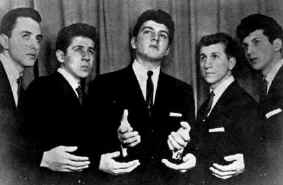
(L-R) Nick Naccarto, Mike Miniceli,
Nick Santo, John Cassese, Frank Reina
The Capris met while playing baseball for Saint Athony's High in
New York City in 1957.
Members:
Nick Santo - real name: Santamaria - lead
Mike Miniceli - first tenor
Frank Reina - bass
Vin Naccarato - second tenor
John Cassese - bass
The only major Capris hit, the romantic "There's a Moon
Out Tonight," is a New York street-corner harmony classic.
Doo-wop was back in fashion by 1961, and it was no longer limited
to R&B aggregations. The Capris met while playing
baseball for St. Anthony's High School in New York in 1957.
Led by Nick Santo (born Nick Santamaria in 1941), the Capris
named themselves after the Isle of Capri in Italy. The Queens,
NY, natives originally cut "There's a Moon Out Tonight"
for the obscure Planet imprint in 1958, but when the song was
reissued on Lost Nite (and eventually on Old Town) it became a
national smash its second time around in early 1961. After many
moons out of the spotlight, the Capris came back triumphantly in
1981 with an album on Ambient Sound and an appearance on the
PBS-TV series "Soundstage." ~ Bill Dahl, All-Music
Guide
The Capris were inducted into the Vocal Group
Hall of Fame in 2007
Cellos
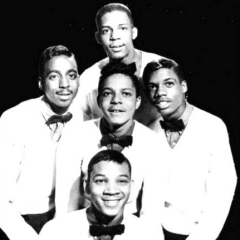
A New York street corner group that could really sing, the Cellos
choose to make their niche oddball world of novelty records.
Members:
Alton Campbell - lead
Billy Montgomery - first tenor
Cliff Williams - second tenor
Bobby Thomas - baritone
Alvin Williams - bass
This five-man group formed in 1955 in Manhattan,
influenced by local high school stars (the Kodoks, the Crests,
the Schoolboys, and the Keynotes). After school harmonizing led
to the Cellos making a $4 demo, which in true Hollywood movie
tradition got them a recording contract! Though their moment in
the spotlight was relatively brief, hitting the charts with their
first single -- "Rang Tang Ding Dong (I Am the Japanese
Sandman)" -- their street-corner sound nonetheless
exemplifies New York doo-wop in its earliest stages. ~ Cub Koda,
All-Music Guide
Earl
Lewis and the Channels
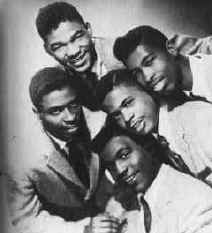
Clockwise from the top: Larry Hampden,
Billy Morris, Edward Doulphin, Earl Lewis
The Channels were a group that became very popular
despite not having a national hit
Members:
Earl Lewis - lead
Larry Hampden - first tenor
Billy Morris - second tenor
Edward Doulphin - baritone
Clifton Wright - bass
While never having a run of hits, the Channels were among the
most popular East Coast doo wop ensembles. Larry Hampden, Billy
Morris, and Edward Doulphin were charter members of the Channels,
who formed in 1955. They started with two part-time members, but
then absorbed lead vocalist Earl Michael Lewis and Clifton Wright
from the Lotharios. Lewis became their principal songwriter and
he penned their best-known hit, "The Closer You Are."
The Channels also brought a fresh style to doo wop singing with
their practice of opening a verse in five-part harmony, then
having Lewis sing lead in the bridge. Later releases like
"The Gleam in Your Eye" and "I Really Love
You" were superbly performed, but never got the push needed
for national recognition. They later recorded for Gone, Fury,
Port, Hit, Enjoy, and Groove with numerous personnel changes. ~
Ron Wynn, All-Music Guide
Charms
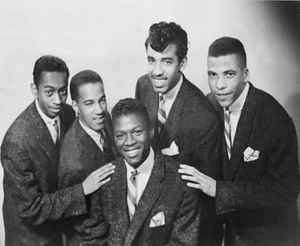
( L to R): Donald Peak, Richard Parker,
Otis Williams, Roland Bradley, Joe Penn
The Charms were one of the most popular rhythm and blues acts of
the mid-50s
Members:
Otis Williams - lead
Donald Peak - first tenor
Roland Bradley - second tenor
Joseph Penn - baritone
Richard Parker - bass
A Cincinnati vocal group who landed a number-one
R&B hit for almost ten weeks in 1954 with "Hearts of
Stone," a song that remains among the most enduring doo wop
anthems. Otis Williams, Richard Parker, Donald Peak, Joe Penn,
and Rolland Bradley first recorded for Rockin' in 1953, but did
"Hearts of Stone" for Deluxe the next year. They had
several other hits, among them "Ling, Ting, Tong,"
"Two Hearts," "Ivory Tower," and
"United," all of which made the Top Ten on the R&B
charts between 1955 and 1957. Their songs were issued as Otis
Williams and His Charms in 1956 and 1957. Williams later tried
his hand at country. -- Ron Wynn, All-Music Guide







